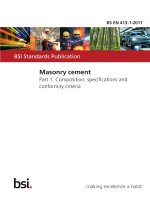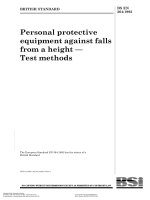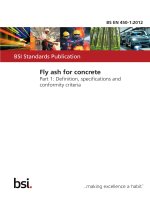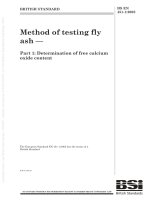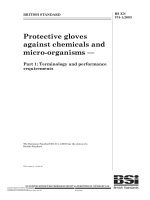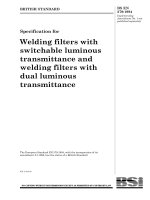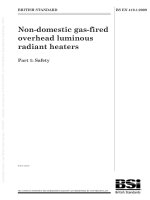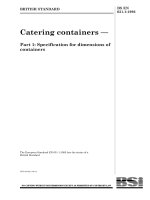Bsi bs en 00720 1 1999
Bạn đang xem bản rút gọn của tài liệu. Xem và tải ngay bản đầy đủ của tài liệu tại đây (101.72 KB, 12 trang )
BRITISH STANDARD
Transportable gas
cylinders Ð Gases and
gas mixtures Ð
Part 1: Properties of pure gases
The European Standard EN 720-1:1999 has the status of a
British Standard
ICS 23.020.30; 71.100.20; 75.160.30
NO COPYING WITHOUT BSI PERMISSION EXCEPT AS PERMITTED BY COPYRIGHT LAW
|
|
|
|
|
|
|
|
|
|
|
|
|
|
|
|
|
|
|
|
|
|
|
|
|
|
|
|
|
|
|
|
|
|
|
|
|
|
|
|
|
|
|
|
|
|
|
|
|
|
|
|
|
|
|
|
|
|
|
|
|
|
|
|
|
|
|
|
|
|
|
|
|
|
|
|
|
|
|
|
|
|
|
|
|
|
|
|
|
|
|
|
|
|
|
|
|
|
|
|
|
|
|
|
|
|
|
|
|
|
|
|
|
|
|
|
|
|
|
|
|
|
|
|
|
|
|
|
|
BS EN
720-1:1999
BS EN 720-1:1999
National foreword
This British Standard is the English language version of EN 720-1:1999.
The UK participation in its preparation was entrusted by Technical Committee
PVE/3, Gas containers, to Subcommittee PVE/3/1, Valve fittings for gas cylinders,
which has the responsibility to:
Ð aid enquirers to understand the text;
Ð present to the responsible international/European committee any enquiries
on the interpretation, or proposals for change, and keep the UK interests
informed;
Ð monitor related international and European developments and promulgate
them in the UK.
A list of organizations represented on this subcommittee can be obtained on request
to its secretary.
Cross-references
The British Standards which implement international or European publications
referred to in this document may be found in the BSI Standards Catalogue under the
section entitled ªInternational Standards Correspondence Indexº, or by using the
ªFindº facility of the BSI Standards Electronic Catalogue.
A British Standard does not purport to include all the necessary provisions of a
contract. Users of British Standards are responsible for their correct application.
Compliance with a British Standard does not of itself confer immunity
from legal obligations.
Summary of pages
This document comprises a front cover, an inside front cover, the EN title page,
pages 2 to 8, an inside back cover and a back cover.
The BSI copyright notice displayed throughout this document indicates when this
document was last issued.
This British Standard, having
been prepared under the
direction of the Engineering
Sector Committee, was published
under the authority of the
Standards Committee and comes
into effect on 15 August 1999
BSI 08-1999
ISBN 0 580 32138 X
Amendments issued since publication
Amd. No.
Date
Comments
EN 720-1
EUROPEAN STANDARD
NORME EUROPÊENNE
EUROPẰISCHE NORM
April 1999
ICS 23.020.30; 71.100.20; 75.160.30
English version
Transportable gas cylinders Ð Gases and gas mixtures Ð
Part 1: Properties of pure gases
Bouteilles aÁ gaz transportables Ð Gaz et meÂlanges
de gaz Ð
Partie 1: ProprieÂteÂs des gaz purs
Ortsbewegliche Gasflaschen Ð Gase und
Gasgemische Ð
Teil 1: Eigenschaften von Einzel Ð Gasen
This European Standard was approved by CEN on 20 December 1998.
CEN members are bound to comply with the CEN/CENELEC Internal Regulations
which stipulate the conditions for giving this European Standard the status of a
national standard without any alteration. Up-to-date lists and bibliographical
references concerning such national standards may be obtained on application to
the Central Secretariat or to any CEN member.
This European Standard exists in three official versions (English, French, German).
A version in any other language made by translation under the responsibility of a
CEN member into its own language and notified to the Central Secretariat has the
same status as the official versions.
CEN members are the national standards bodies of Austria, Belgium, Czech
Republic, Denmark, Finland, France, Germany, Greece, Iceland, Ireland, Italy,
Luxembourg, Netherlands, Norway, Portugal, Spain, Sweden, Switzerland and
United Kingdom.
CEN
European Committee for Standardization
Comite EuropeÂen de Normalisation
EuropaÈisches Komitee fuÈr Normung
Central Secretariat: rue de Stassart 36, B-1050 Brussels
1999 CEN All rights of exploitation in any form and by any means reserved worldwide for CEN national
Members.
Ref. No. EN 720-1:1999 E
Page 2
EN 720-1:1999
Foreword
This European Standard has been prepared by
Technical Committee CEN/TC 23, Transportable gas
cylinders, the Secretariat of which is held by BSI.
This European Standard shall be given the status of a
national standard, either by publication of an identical
text or by endorsement, at the latest by October 1999,
and conflicting national standards shall be withdrawn
at the latest by October 1999.
According to the CEN/CENELEC Internal Regulations,
the national standards organizations of the following
countries are bound to implement this European
Standard: Austria, Belgium, Czech Republic, Denmark,
Finland, France, Germany, Greece, Iceland, Ireland,
Italy, Luxembourg, Netherlands, Norway, Portugal,
Spain, Sweden, Switzerland and the United Kingdom.
This European Standard has been submitted for
reference into the RID and/or in the technical annexes
of the ADR. Therefore in this context the standards
listed in the normative references and covering basic
requirements of the RID/ADR not addressed within the
present standard are normative only when the
standards themselves are.
Contents
Foreword
Introduction
1
Scope
2
Normative references
3
Definitions
4
Properties of gas mixtures
5
Code number
6
List of gases
Page
3
3
3
3
3
3
4
4
BSI 08-1999
Page 3
EN 720-1:1999
Introduction
3 Definitions
In Europe there are 2 existing Directives which deal
with the classification of gases. One relates to
Dangerous Substances and Preparations, the other to
the Transport of Dangerous Goods (ADR). These
Directives have several conflicting classifications,
e.g. toxicity is expressed in volume parts per million
(p.p.m.V) in the ADR Directive and in milligrams per
litre (mg/l) in the Substances and Preparations
Directive.
The purpose of this standard is to list the properties of
individual gases to facilitate the selection of valve
outlets.
This is different from the scope of the two Directives
mentioned above, which are concerned with hazard
identification and transport matters respectively.
Consequently this standard is not in conflict with
either of the two above Directives as it specifically
addresses the risks of misconnection of equipment
e.g. Chlorine is not an oxidant according to Transport
Regulations, but the risk of mixing this gas with
flammable gas is well known and is addressed in this
standard.
For the purpose of this European Standard, the
following definitions apply.
1 Scope
The purpose of this part of EN 720 is to define the
properties of gases on the basis of four main
physical±chemical criteria i.e. fire potential, toxicity,
state of gas and corrosiveness (see clause 3) for the
purpose of the selection of suitable valve outlets.
NOTE See 3.4 for the definition of corrosiveness.
2 Normative references
This European Standard incorporates by dated or
undated reference, provisions from other publications.
These normative references are cited at the
appropriate places in the text and the publications are
listed hereafter. For dated references, subsequent
amendments to or revisions of any of these
publications apply to this European Standard only
when incorporated in it by amendment or revision. For
undated references the latest edition of the publication
referred to applies.
EN 720-2, Classification of gases and gas mixtures Ð
Part 2: Gases and gas mixtures Ð Determination of
fire potential and oxidizing ability.
EN ISO 11114-1, Transportable gas cylinders Ð
Compatibility of cylinder and valve materials with
gas contents Ð Part 1: Metallic materials.
BSI 08-1999
3.1
fire potential
a gas or gas mixture is said to be flammable in air if it
will ignite in air at atmospheric pressure and at a
temperature of 20 8C. The minimum content of gas or
gas mixture at which it ignites is called the lower
flammability limit in air. This limit is determined at
atmospheric pressure and at a temperature of 20 8C
a gas or a gas mixture which is less oxidizing than air
is not able, at atmospheric pressure, to support the
combustion of substances, which are flammable in air
3.2
toxicity
toxicity is characterized by the 50 % lethal
concentration. In this standard the 50 % lethal
concentration (LC50) is the concentration of a gas in
air, expressed in p.p.m.V., administered in a single
exposure during a short period of time (24 h or less) to
a group of young adult albino rats (males and females)
which results in the death of half of the animals in a
period of at least 14 days (see 5.2)
3.3
state of gas
the physical state in which gases may be stored and
transported in cylinders. Four categories are adopted:
Ð deeply refrigerated liquefied;
Ð liquefied;
Ð compressed;
Ð dissolved
3.4
corrosiveness
ability of the gas to damage or to destroy external
living tissues (eyes and skin). Gases are assigned a
corrosiveness category. This is not to be confused with
corrositivity of gases with metallic materials
(see EN ISO 11114-1)
4 Properties of gas mixtures
From the properties of the various components given
in clause 6, the properties of the gas mixtures may be
determined by using the appropriate standard on gas
mixtures concerning each of the physico-chemical
criteria indicated in clause 1 (see EN 720-2 for the fire
potential).
Page 4
EN 720-1:1999
5 Code number
To be able to recognize the properties of a gas, a code
number (FTSC) is given. This code number assigned to
each gas is based on the following four
physico-chemical criteria:
Category I:
Category II:
Category III:
Category IV:
fire potential, defining the gas
behaviour with respect to
flammability (see 3.1);
toxicity determined by the 50 %
lethal concentration (see 3.2);
gas state, defining the physical state
of the contents in the cylinder
at 15 8C within a given pressure
range (see 3.3);
corrosiveness (see 3.4).
Each category is composed of different sub-divisions,
each identified by a different digit. In this way a gas, in
a given state, is characterized by a series of four digits
(one digit per category) as shown in 5.1 to 5.5.
5.1 Fire potential (category I)
For fire potential, gases are divided in 6 subdivisions:
Subdivision 0: inert (any gas not classified under
subdivisions 1 to 5 below);
Subdivision 1: supports combustion (oxidizing gas
having an oxidant potential equal to
or less than that of air);
Subdivision 2: flammable (gas having flammable
limits in air) (see 3.1);
Subdivision 3: spontaneously flammable;
Subdivision 4: highly oxidizing (see 3.1) (oxidizing
gas having an oxidant potential
greater than that of air);
Subdivision 5: flammable and subject to
decomposition or polymerization.
5.2 Toxicity (category II)
For toxicity, gases are divided into five subdivisions:
Subdivision 0: life supporting;
Subdivision 1: asphyxiant (when LC50 is greater
than 15 000 p.p.m.V);
Subdivision 2: toxic and asphyxiant
(when 200 p.p.m.V # LC50
# 5 000 p.p.m.V);
Subdivision 3: very toxic and asphyxiant
(when LC50 # 200 p.p.m.V);
Subdivision 9: harmful and asphyxiant
(when 5 000 p.p.m.V # LC50
15 000 p.p.m.V)
5.3 State of the gas in the cylinder at 15 8C
(category III)
For state of the gas, gases are divided into
8 subdivisions:
Subdivision 0: liquefied gas at 35 bar or less;
Subdivision 1: liquefied gas at over 35 bar;
Subdivision 2: liquid withdrawal Ð liquefied gas
(optional);
Subdivision 3: dissolved gas;
Subdivision 4: 35 bar or less Ð gas only (including
cryogenic gas withdrawal);
Subdivision 5: medium pressure range,
compressed gases from 35 bar up
to and including 250 bar;
Subdivision 7: high pressure range, above 250 bar
and up to and including 400 bar;
Subdivision 8: very high pressure, above 400 bar.
NOTE Subdivision 6 is not used here because it is used by
the U.S.
5.4 Corrosiveness (category IV)
For corrosiveness, gases are divided into
4 subdivisions:
Subdivision 0:
Subdivision 1:
Subdivision 2:
Subdivision 3:
non-corrosive;
non-halogen acid forming;
basic;
halogen acid forming.
5.5 Designation of the code
This code is called FTSC code:
F:
T:
S:
C:
for fire potential, defining the gas behaviour
with respect to flammability;
for toxicity;
for gas state, defining the physical state of the
contents in the cylinder at 15 8C within a given
pressure range;
for corrosiveness.
6 List of gases
NOTE For compressed gases the third digit used in this standard
is a 5. Most of these gases may be filled at higher pressure and
consequently the relevant digit 7 or 8 shall then be used. For
liquefied gases the third digit used in this standard is 0 or 1
(depending on the pressure). Most of these gases may be used
with liquid withdrawal and consequently the relevant digit 2 shall
then be used (irrespective of the pressure).
where LC50 values correspond to 1 h exposure and
mortality in 14 days and with p.p.m.V corresponding to
the parts per million by volume.
BSI 08-1999
Page 5
EN 720-1:1999
Gas
Synonym
Code Number
Acetylene
Air
Allene
Ammonia
Antimony pentafluoride
Argon
Arsine
Bis-trifluoromethylperoxide
Boron trichloride
Boron trifluoride
Bromine pentafluoride
Bromine trifluoride
Bromoacetone
Bromochlorodifluoromethane
Bromochloromethane
Bromotrifluoromethane
Bromotrifluoroethylene
1,3-Butadiene (inhibited)
Butane
1-Butene
2-Butene
Carbon dioxide
Carbon monoxide
Carbonylfluoride
Carbonyl sulfide
Chlorine
Chlorine pentafluoride
Chlorine trifluoride
1-Chloro-1,1-difluoroethane
1-Chloro-1,2,2,2 tetrafluoroethane
1-Chloro-2,2,2 trifluoroethane
Chlorodifluoromethane
Chlorofluoromethane
Chloroheptafluorocyclobutane
Chloromethane
Chloropentafluoroethane
Chlorotrifluoromethane
Chlorotrifluoroethylene
Coal gas
Cyanogen
Cyanogen chloride
Cyclopropane
Deuterium
Deuterium chloride
Deuterium fluoride
Deuterium selenide
Deuterium sulfide
Diborane
Dibromodifluoromethane
1,2-Dibromotetrafluoroethane
Ethyne
5130
1050
2100
2902
0303
0150
2300
4300
0203
0253
4303
4303
0203
0100
0100
0100
2100
5100
2100
2100
2100
0110
2250
0213
2201
4203
4303
4203
2100
0100
0100
0100
2100
0100
2900
0100
0100
5200
Mixture
2200
0303
2100
2150
0213
0203
2301
2201
5350
0100
0100
BSI 08-1999
Propadiene
R717
Boron chloride
Boron fluoride
R12B1
Trifluorobromomethane R13B1
R113B1
Butylene
Butylene
Carbonic acid R744 anhydride
Carbonoxylsulfide
R142b
R124
R133a
Monochlorodifluoromethane R22
C317
Methyl chloride R40
Monochloropentafluoroethane R115
Monochlorotrifluoromethane
R1113
Trimethylene
R12B2
R114B2
Page 6
EN 720-1:1999
Gas
Synonym
Code Number
2,2-Dichloro-1,1,1 trifluoroethane
Dichloro-2-chlorovinylarsine
1,2-Dichlorodifluoroethylene
Dichlorodifluoromethane
Dichlorofluoromethane
1,2-Dichlorohexafluorocyclobutane
Dichlorosilane
1,1-Dichlorotetrafluoroethane
1,2-Dichlorotetrafluoroethane
Diethylzinc
1,1-Difluoroethane
1,1-Difluoroethylene
Difluoromethane
Dimethyl ether
Dimethylamine
2,2-Dimethylpropane
Dimethylsilane
Diphosgene
Ethane
Ethylchloride (flamable liquid)
Ethyl ether
Ethylacetylene
Ethyldichloroarsine
Ethylene
Ethylene oxide
Fluorine
Fluoroethane
Germane
Helium
Heptafluorobutyronitrile
Hexafluoroacetone
Hexafluorocyclobutene
Hexafluoroethane
Hexafluoropropylene
Hydrogen
Hydrogen bromide
Hydrogen chloride
Hydrogen cyanide
Hydrogen fluoride
Hydrogen iodide
Hydrogen selenide
Hydrogen sulfide
Iodotrifluoromethane
Iodine pentafluoride
Isobutane
Isobutylene
Krypton
Methane
Methyl acetylene
Methyl bromide
R123
Lewisite
R1112a
R12
R21
C316
0100
0303
0100
0100
0100
0100
2203
0100
0100
3300
2100
2110
0110
2100
2902
2100
2100
0303
2100
2100
2100
2100
0303
2150
5200
4343
2100
2300
0150
2300
0203
2100
0100
0100
2150
0203
0213
5301
0203
0203
2301
2201
0100
4303
2100
2100
0150
2150
2100
0200
R114a
R114
Ethylidene fluoride R152a
Vinylidene fluoride R1132a
Methlylene fluoride
Methyl ether
Neopentane Tetramethylmethane
R170
Chloroethane R160
R1150
1-Butyne
Ethene
Oxirane
Ethyl fluoride
Hexafluoropropan-2; perfluoroacetone
Perfluoroethane R116
Hexafluoropropene
Hydrobromic acid (anhydrous)
Hydrochloric acid (anhydrous)
Hydrocyanic acid (anhydrous)
Hydrofluoric acid (anhydrous)
Hydroiodic acid (anhydrous)
Trifluoromethyl iodide
Trimethylmethane R601
Isobutene; 2-methylpropene
R50
Allylene; propyne
Bromomethane
BSI 08-1999
Page 7
EN 720-1:1999
Gas
Synonym
Code Number
Methyl Ethyl Ether
Methyl fluoride
Methyl mercaptan
Methyl-3-Butene
Methyldichloroarsine
Methylsilane
Methylvinylether (inhibited)
Monoethylamine
Monomethylamine
Mustard gas
Natural gas
Neon
Nitric oxide
Nickel carbonyl
Nitrogen
Nitrogen dioxide
Ethyl Methyl Ether
Fluoromethane R41
Methanethiol
Isoamvlene ± Isopropvlethvlene
2100
2110
2201
2100
030
2100
5100
2102
2902
0303
2150
0150
4351
2300
0150
4301
Nitrogen trioxide
Nitrosyl chloride
Nitrous oxide
Octafluorocyclobutane
Octafluoropropane
Oxygen
Oxygen difluoride
Ozone
Pentaborane
Pentachlorofluoroethane
Pentafluoroethane
Pentafluoroethyliodide
Pentafluoropropionitrile
Perfluoro-2-butene
Perfluorobutane
Phenylcarbylamine chloride
Phosgene
Phosphine
Phosphorus pentafluoride
Phosphorus trifluoride
Propane
Propylene
Propylene oxide
Silane
Silicon tetrachloride
Silicon tetrafluoride
Stibine
Sulfur dioxide
Sulfur hexafluoride
Sulfur tetrafluoride
BSI 08-1999
Methoxyethylene
Ethylamine R631
Methylamine R630
Nitrogen (II) oxide
Nickel tetracarbonyle
Liquid dioxide Nitrogen (IV) oxide
Dinitrogentetraoxide
peroxide Nitrogen tetroxide
Nitrogen sesquioxide
Dinitrogen trioxide Nitrogen
Nitrogen (III) oxide
Perfluorocyclobutane C318
Perfluoropropane R218
R125
Carbonyl chloride
R290
Propene R1270
Methyl oxirane
Silicone tetrahydride
Tetrafluorosilane R764
Antimonyhydride
4301
0303
4110
0100
0100
4050
4343
4330
3300
0100
0100
0100
2300
0900
0100
0303
0303
3310
0303
0203
2100
2100
5900
3150
0203
0253
5300
0201
0100
0303
Page 8
EN 720-1:1999
Gas
Sulfuryl fluoride
1,1,1,2-Tetrachlorodifluoroethane
1,1,1,2,2-Tetrachlorodifluoroethane
Tetraethyl lead
1,1,1,2-Tetrafluoroethane
1,1,2,2-Tetrafluoro-1 chloroethane
Tetrafluoroethylene
Tetrafluoromethane
Tetramethyl lead
Trichlorofluoromethane
1,1,1-Trichlorotrifluoroethane
1,1,1-Trichlorotrifluoroethane
Triethyl aluminium
Triethyl borane
Trifluoroacetonitrile
1,1,1-Trifluoroethane
Trifluoroethylene
Trifluoromethane
Trimethylamine
Trimethylstibine
Trimethylsilane
Tungsten hexafluoride
Uranium hexafluoride
Vinyl Bromide (inhibited)
Vinyl Chloride (inhibited)
Vinyl Fluoride (inhibited)
Xenon
Synonym
R112a
R112
R134a
Carbon tetrafluoride R1114
Carbon tetrafluoride R14
Trichloromonofluoromethane R11
R113a
R113
R143a
Fluoroform R23
Chloroethylene R1140
Fluoroethylene R1141
Code Number
0203
0100
0100
2300
0100
0100
0100
0150
2200
0100
0100
0100
3300
3200
2200
2100
2200
0100
2902
3300
2100
0303
0303
5100
5100
5100
0150
BSI 08-1999
blank
BS EN
720-1:1999
BSI
389 Chiswick High Road
London
W4 4AL
|
|
|
|
|
|
|
|
|
|
|
|
|
|
|
|
|
|
|
|
|
|
|
|
|
|
|
|
|
|
|
|
|
|
|
|
|
|
|
|
|
|
|
|
|
|
|
|
|
|
|
|
|
|
|
|
|
|
|
|
|
|
|
|
|
|
|
|
|
|
|
|
|
|
|
|
|
|
|
|
|
|
|
|
|
|
|
|
|
|
|
|
|
|
|
|
|
|
|
|
|
|
|
|
|
|
|
|
|
|
|
|
|
|
|
|
|
|
|
|
|
|
|
|
|
|
|
BSI Ð British Standards Institution
BSI is the independent national body responsible for preparing British Standards. It
presents the UK view on standards in Europe and at the international level. It is
incorporated by Royal Charter.
Revisions
British Standards are updated by amendment or revision. Users of British Standards
should make sure that they possess the latest amendments or editions.
It is the constant aim of BSI to improve the quality of our products and services. We
would be grateful if anyone finding an inaccuracy or ambiguity while using this
British Standard would inform the Secretary of the technical committee responsible,
the identity of which can be found on the inside front cover. Tel: 020 8996 9000.
Fax: 020 8996 7400.
BSI offers members an individual updating service called PLUS which ensures that
subscribers automatically receive the latest editions of standards.
Buying standards
Orders for all BSI, international and foreign standards publications should be
addressed to Customer Services. Tel: 020 8996 9001. Fax: 020 8996 7001.
In response to orders for international standards, it is BSI policy to supply the BSI
implementation of those that have been published as British Standards, unless
otherwise requested.
Information on standards
BSI provides a wide range of information on national, European and international
standards through its Library and its Technical Help to Exporters Service. Various
BSI electronic information services are also available which give details on all its
products and services. Contact the Information Centre. Tel: 020 8996 7111.
Fax: 020 8996 7048.
Subscribing members of BSI are kept up to date with standards developments and
receive substantial discounts on the purchase price of standards. For details of
these and other benefits contact Membership Administration. Tel: 020 8996 7002.
Fax: 020 8996 7001.
Copyright
Copyright subsists in all BSI publications. BSI also holds the copyright, in the UK, of
the publications of the international standardization bodies. Except as permitted
under the Copyright, Designs and Patents Act 1988 no extract may be reproduced,
stored in a retrieval system or transmitted in any form or by any means ± electronic,
photocopying, recording or otherwise ± without prior written permission from BSI.
This does not preclude the free use, in the course of implementing the standard, of
necessary details such as symbols, and size, type or grade designations. If these
details are to be used for any other purpose than implementation then the prior
written permission of BSI must be obtained.
If permission is granted, the terms may include royalty payments or a licensing
agreement. Details and advice can be obtained from the Copyright Manager.
Tel: 020 8996 7070.
